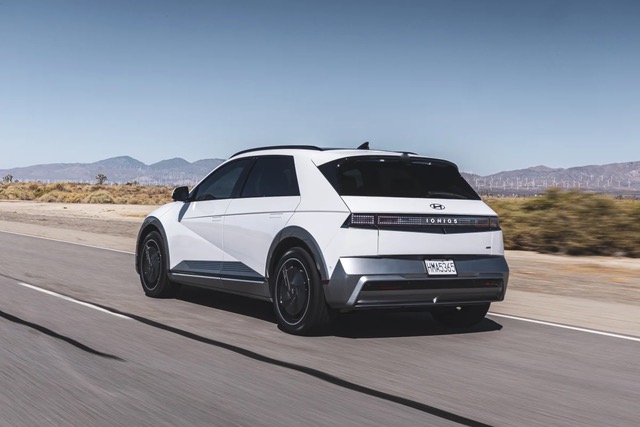
The 2025 Hyundai Ioniq 5, the fourth model year of the compact crossover sport utility, further improves the South Korean carmaker’s electric vehicle presence.
Introduced globally in 2021 as a 2022 model, Hyundai hoped the Ioniq 5 and its expanding lineup of siblings would infiltrate the market. Primary rivals were once the Toyota Prius and Nissan Leaf. Now, there’s more prominent competition.
The Ioniq 5 (it’s marketed as the IONIQ 5) has succeeded better than anticipated. It combines overall inside and outside handsomeness, simplistic and innovative retro-futuristic styling and fast recharging.
Most importantly, for the still-concerned EV skeptics, the charging range requirements have improved. It’s added to Hyundai’s EV clout.
Tesla sales dramatically slumped from 2023 to 2024, but the manufacturer still had three of the top five best-selling EVs in the United States last year. The Ioniq was the country’s fourth best-selling EV, trailing the Tesla Model Y, Tesla Model 3 and Ford Mustang Mach-E. Tesla’s Cybertruck was fifth.
Available in SE, SEL, Limited and XRT trims, the Ioniq 5 features an electric-only powertrain. The standard range battery is paired with a single, rear-mounted motor generating 168 horsepower. The reviewed Limited trim has a longer-range battery (318 miles) and its two-motor, rear-wheel-drive configuration generates 225 horsepower. It accelerates from 0 to 60 miles per hour in 4.7 seconds.
The Ioniq 5 comes standard with the Tesla-configured NACS charging port. It’s the first non-Tesla vehicle to feature a factory-installed native NACS port.
But a CCS adapter is included as a standard addition and is stored in the small frunk. It attaches easily and gives the EV the full range of public charging options and fast charging with NACS option. The EPA ratings for the Limited trim are 129 MPGe in city driving, 100 MPGe on the highway.
While there’s some wind rush, the Ioniq advances smoothly and quietly. It impressively absorbs road imperfections. The ride quality is complemented via the design and craftsmanship of the interior.
While still the original generation, the interior has new higher-grade seating materials. The phone-charging pad is no longer “hidden.” It’s now positioned on the top of the center platform between the front seats. Place your device on the pad and a small horizontal row of green lights indicate the phone is charging.
Further convenient, the interior door handles aren’t handles but door “canals.” The doors can be closed by grabbing anywhere in the channel.
Additional changes include a new bank of buttons that provide quicker and easier access to engage the heated seats and heated steering wheel. The infotainment system also has several new features, including a more advanced lane-keeping assist system and a side-impact collision avoidance feature.
Overall, the interior is a minimalist’s delight. The feeling of openness is refreshing, the lack of complication is inviting.
The Ioniq 5 has practical, sufficient cargo space, 27.2 cubic behind the rear seats, 59.3 cubic feet when the seats are folded flat. Several competitors have larger areas. A small front compartment (frunk) provides enough room for the Ioniq 5’s charging cable and adapters. A hands-free power liftgate is available.
The two-row Ioniq 5 seats five, with standard amenities like cloth upholstery, an eight-way power-adjustable driver’s seat and heated front seats.
Options include synthetic leather upholstery, driver’s seat memory settings, ventilated front seats, an eight-way power-adjustable passenger seat, a heated steering wheel, a front sliding center console and a rear center armrest.
The 2025 Ioniq 5 is assembled in Georgia and beginning in May, the $7,500 federal tax rebate was reinstated if buyers meet certain requirements. California also has as much as a $1,500 EV rebate with varied requirements.
As reviewed, the 2025 Hyundai Ioniq 5 costs just under $57,000. With applicable rebates, the tally is a few thousand dollars less than the average price of a new vehicle in the United States. It’s among the best 2025 automotive values.
James Raia, a syndicated automotive columnist in Sacramento, also contributes business, lifestyle and sports content to several print and online publications. E-mail: [email protected].